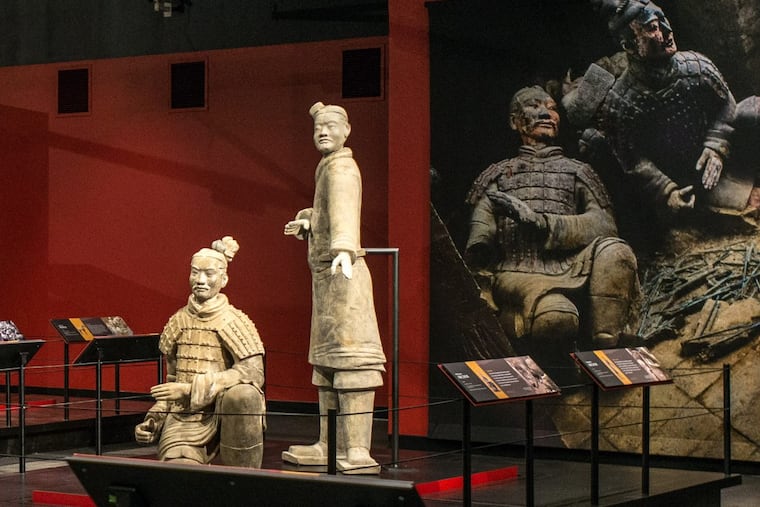Why the Terracotta Warriors are so special, and how to see them in Philly
The Franklin Institute on Saturday unveils Terracotta Warriors of The First Emperor, an ambitious, tremendously inventive exhibit about one of China's richest archaeological treasures, the massive collection of life-size clay soldiers that were crafted some 2,200 years ago and unearthed by farmers in 1974 in eastern China.

The Franklin Institute on Saturday will unveil Terracotta Warriors of The First Emperor, an ambitious, tremendously inventive exhibit about one of China's richest archaeological treasures: the massive collection of life-size clay soldiers crafted roughly 2,200 years ago and unearthed by farmers in eastern China in 1974.
Featuring 10 terra-cotta warriors — the most ever lent to a North American exhibit — the traveling show will stop at only two cities, Seattle and Philly.
It'll be at the Franklin Institute through March 4, 2018.
"So, 30 years ago, China allowed about three of them to come to Philadelphia," said Franklin Institute president and CEO Larry Dubinski. "Now they let us exhibit 10 of them, which is pretty amazing."
Karen Elinich, the institute's director of science content, chimed in, "It's also extremely rare — almost unheard of — to be allowed to exhibit them outside glass cases."
Dubinski and Elinich were part of a team of curators the institute sent to China last year to choose items for the exhibit, a multidisciplinary, multimedia, multiroom experience that takes up 14,000 square feet of exhibit space.
Featuring 160 other artifacts and dozens of full-size terra-cotta warrior replicas, the show uses each of the 10 figures as the centerpiece of an elaborate mise-en-scène that illuminates a different aspect of life in China during the 3rd century B.C., when the warriors were built. It also tells the story of China's first emperor, Qin Shihuangdi, who had them built to accompany him into the afterlife.
"And since we're the Franklin, there's a strong science and technology element to the exhibit as well," Dubinski said.
The exhibit also will include an Augmented Reality component: Visitors with the Franklin Institute app on their smartphones can access a wealth of extra visual detail and information about eight of the 10 warriors.
"Use your smartphone to scan special tags on the displays," Dubinski said, "and you can look at the warrior surrounded by virtual-reality elements."
The exhibit also has a film element; the documentary Mysteries in China will be featured in the Tuttleman IMAX Theater.
The emperor’s dollhouse
The story of the terra-cotta warriors is framed by two great mysteries, Elinich said.
"First there's the mystery of [the warriors'] discovery by the farmers. What did all this terra-cotta material mean?" she said. Little was known about Qin Shihuangdi, who united China in 221 B.C. but whose dynasty only lasted a few years until his death in 210 BC.
"Further digging revealed a tomb which is massive — 22 square miles."
Built by the first emperor as his last resting place, the underground compound is a city unto itself, featuring an orderly system of chambers and corridors filled with about 8,000 clay warriors and a priceless collection of bronze statues and various other artworks and artifacts.
Think of it as history's biggest, most ornate dollhouse.
Archaeologists worked on two fronts: The warriors were painstakingly pieced back together from broken shards, while further excavation revealed the shape of the compound.
"They are still excavating. They have excavated less than 2,000 warriors," Elinich said, "and only a handful of chambers."
It took about 700,000 workers more than 40 years to build the compound. The emperor died before they could finish.
"That's the second great mystery: the emperor's tomb," Elinich said.
The chamber that houses the tomb remains unopened to this day — out of deference for Qin Shihuangdi, yes, but also because the chamber may be toxic. A habitual consumer of mercury, which he believed would make him immortal, the emperor may also have decorated the inner chamber with rivers of the toxic liquid metal.
"We can only speculate, which is why the last room of the exhibit is filled with question marks," Elinich said.
Replicas of the terra-cotta warriors show how they looked before the toll of time destroyed paint and lacquer.
The emperor had an obsession with immortality.
"He would send out emissaries everywhere to find cures for mortality and for extending his life," Elinich said.
"No one is sure how exactly he died, but it's likely that the daily dose of mercury he took to become immortal eventually poisoned and killed him."
Terracotta Warriors of The First Emperor
Through March 4, 2018, at the Franklin Institute, 222 North 20th St.
Hours: The exhibit is open 9:30 a.m. to 5 p.m. Sunday through Wednesday; until 9 p.m. Thursday through Saturday.
Exhibit by Time Slot: To avoid overcrowding, visitors are required to buy tickets for specific time blocks, so advance reservations are recommended.
Tickets: Prices include museum admission. $35; $30 ages 3 to 11 for daytime visits. $20, $15 ages 3-11 for evening visits.
Also on sale: The IMAX film Mysteries in China costs an additional $6.
An accompanying exhibit audio tour in English, Mandarin, and Spanish and will be available for an additional $6.
An accompanying catalog specific to this Exhibition Terracotta Warriors of the First Emperor will be available for $10.
Information: 215-448-1200, fi.edu.